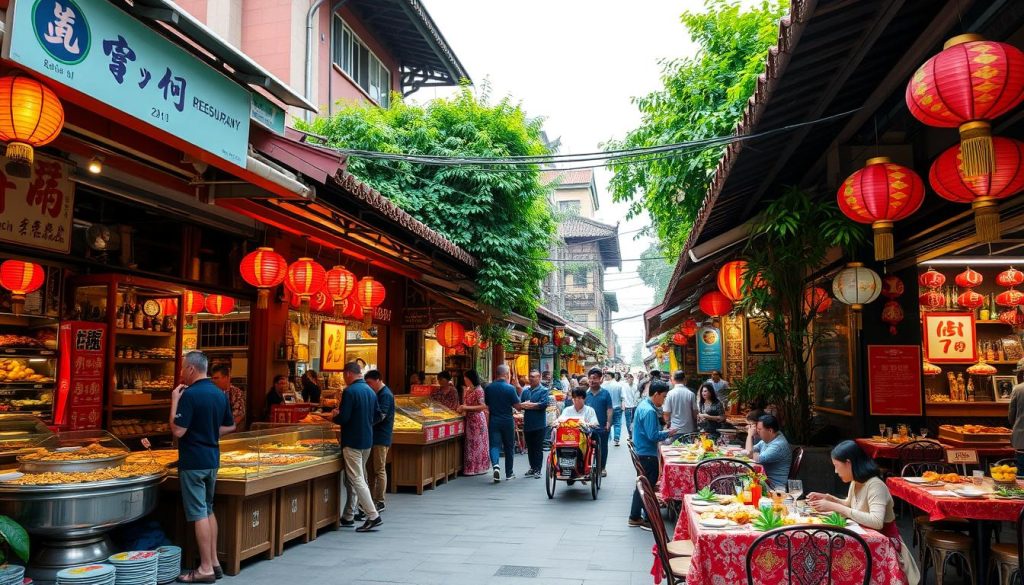Starting a restaurant in Asia is both thrilling and challenging. The area’s varied and rich food scene is full of tastes but also has its own hurdles. Knowing what locals like, dealing with rules, and staying up-to-date with trends are key to success.
We will look at important strategies for a successful restaurant opening. This includes doing deep market research and using creative marketing ideas.
Understanding the Asian Culinary Landscape

The Asian culinary scene is a colourful mix of different cultures and flavours. Each country brings its own taste, ingredients, and cooking ways. For example, Chinese food is all about balance, Indian food is known for its spices, Thai food for its bold tastes, and Japanese food for its focus on presentation.
Asian food trends are shaping the world’s dining scene. People want real experiences that connect them to the roots of these cuisines. Restaurants need to understand these trends to attract both locals and tourists.
Knowing about Asian food helps restaurants create experiences that guests love. By embracing these traditions, they can stay ahead of food trends and add to Asia’s rich food story.
Market Research: An Essential Step

Doing thorough market research is key for restaurants to succeed. It helps them understand who their customers are. This lets them create menus and services that appeal to the local crowd.
It starts with knowing the area’s demographics, tastes, and eating habits. This is the first step in getting to know the local market.
There are many ways to do this research. Here are a few:
- Surveys: Asking people questions can show what they like to eat and how often.
- Focus Groups: Talking to groups of people can give deeper insights into what they want.
- Competitor Analysis: Looking at other restaurants helps find what makes you different and what’s missing.
It’s also important to watch how eating habits change. For example, more people might want healthy food or plant-based meals. This can help shape your menu.
Prices need to match what customers think they’re getting. This way, you can stay competitive and still make money. Knowing what’s new in dining trends is crucial for standing out in the market.
Location, Location, Location
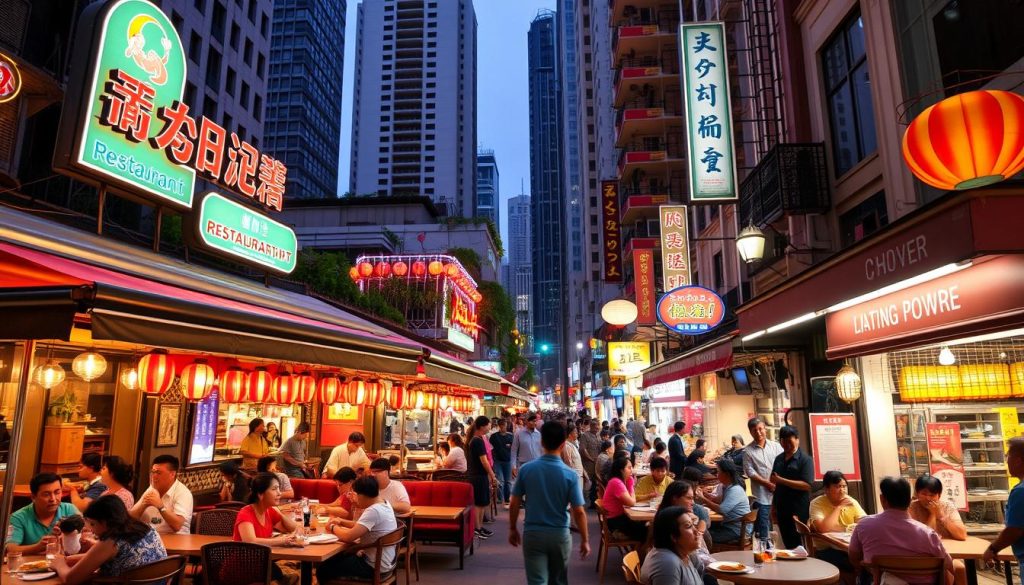
The right location is key to a restaurant’s success. It affects foot traffic, how easy it is to get to, and who else is around. A great spot can bring in more customers, boosting sales.
When picking a location, think about:
- Foot Traffic: More people walking by means more people seeing and visiting your place.
- Accessibility: Easy transport links help more people find and get to your restaurant.
- Competitor Presence: Having nearby competitors can show a strong market. But too many can split your customers.
- Local Demographics: Knowing the area’s age, income, and tastes helps you tailor your menu.
- Visibility: A spot that’s easy to see can attract people who decide to eat out on the spur of the moment.
Doing a deep dive into location analysis can really help your restaurant stand out. It’s not just about how it looks. It’s about how it feels and how it fits into the local scene.
Legal Requirements for Opening a Restaurant in Asia
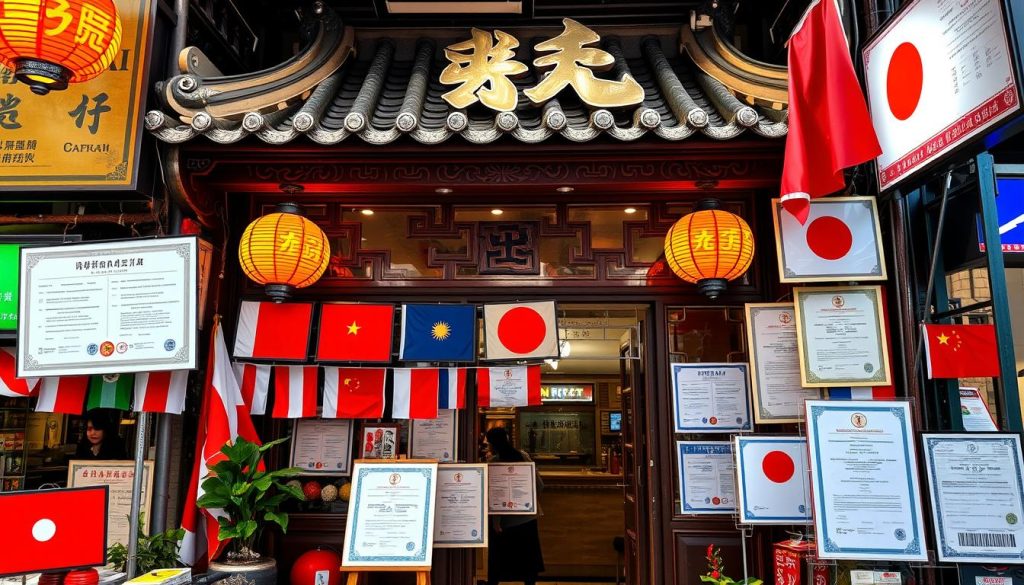
Before starting a restaurant in Asia, it’s vital to know the legal rules. Each country has its own laws and rules. These must be followed carefully to avoid trouble.
- Permits and Licenses:
- Health and safety certifications are needed by local authorities.
- Food handling permits are crucial for staff in food prep and service.
- Business registration is needed to legally operate in the market.
- Regulations in Asia:
- Labour laws differ greatly across countries, affecting hiring and work practices.
- Zoning rules decide where a restaurant can be and what it can do.
Knowing these rules helps entrepreneurs run their businesses legally. It’s wise to research the specific laws of the country you’re targeting. This way, you can avoid any legal issues.
Tips for Opening a Restaurant in Asia
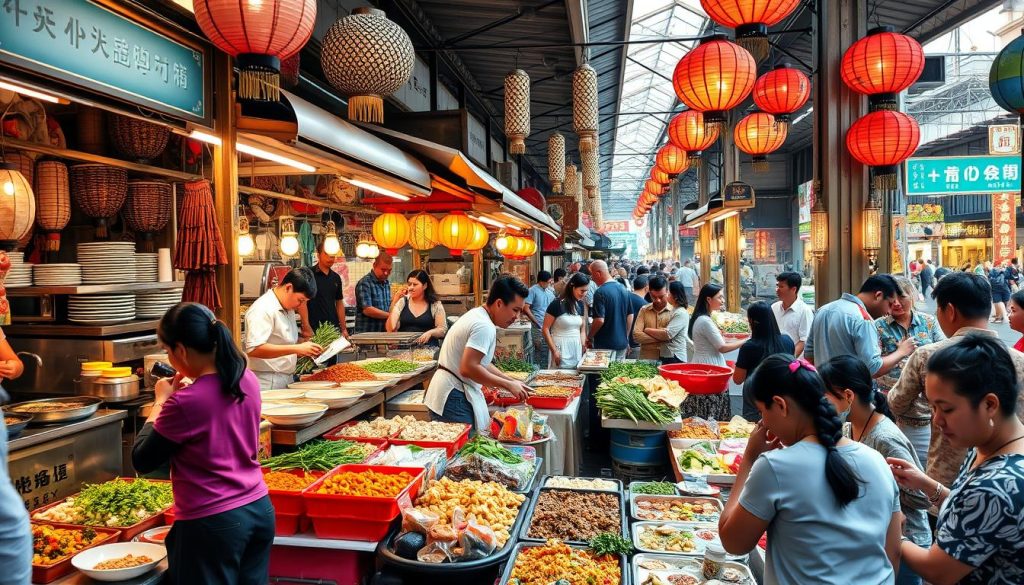
Opening a restaurant in Asia is tough. You need to know the latest in food trends and local tastes. By keeping up with these, you can offer unique dining experiences that people love.
Identifying Culinary Trends
It’s key to stay on top of food trends in Asia. Things like plant-based menus and eco-friendly dining are big hits. By watching what’s popular, you can make your menu appealing to many.
Adding a bit of fusion cuisine can also draw in customers. This makes your place stand out and feel fresh.
Adapting to Local Tastes
Knowing what locals like is vital. Use local ingredients and cooking ways to make your menu special. This shows respect for the culture and makes diners feel at home.
Being flexible with your menu helps too. This way, you can please a wide range of customers. It makes their dining experience better and more fun.
Creating a Business Plan

A good restaurant business plan is like a roadmap for starting and growing a restaurant. It covers important steps for planning, making sure you know how to succeed. First, you need to define what your restaurant is about. Knowing what makes it special and who it’s for helps guide your decisions.
Doing a deep market analysis is key. It shows what customers like and who you’re up against. This helps you place your restaurant where it fits best in the market. Also, having a solid marketing plan is vital. It helps you promote your brand and attract the right customers.
Looking at the financial side is crucial too. It helps you see if your restaurant can make money and stay afloat. By estimating costs and predicting earnings, you get a clear picture of your finances. Setting achievable goals and plans helps build trust with investors and supporters.
Financing Your Restaurant Venture

Starting a restaurant in Asia needs a deep understanding of local economics. The economic environment is key to finding the right financing. Things like inflation, currency stability, and how much people spend affect funding. Knowing these helps restaurateurs make smart financial choices, crucial for getting investment.
Understanding Local Economic Conditions
It’s vital for restaurateurs to grasp the local economy in Asia. A stable economy is good for new businesses, but changes can be tough. Getting to know these conditions helps in planning and making investment decisions.
Securing Investors or Loans
After understanding the economy, restaurateurs can look for investors or loans. There are many options, like venture capital, angel investors, and loans. Loans for restaurants in Asia are getting easier, but a strong pitch is essential.
Investors want clear plans and a solid business model. A well-presented idea can greatly improve your chances of getting funding.
Menu Development and Positioning
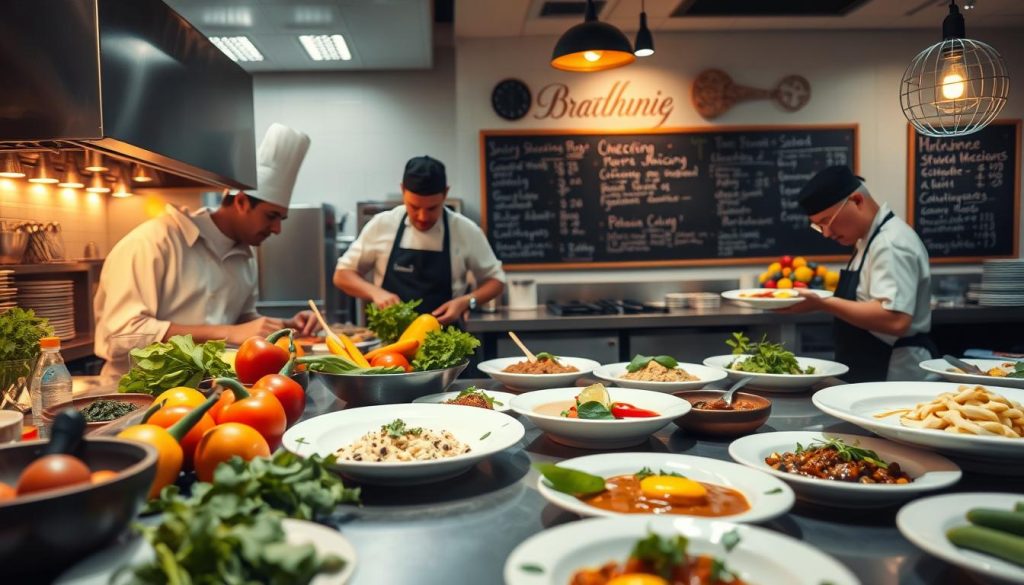
Making a great restaurant menu is key to a good dining experience. It needs to be both creative and practical. Using seasonal foods and special dishes can draw in customers and show off the restaurant’s style.
It’s important to plan how the menu is laid out to affect what customers choose. A good layout makes choosing easier and more enjoyable. It should be clear, look good, and have the right balance of prices.
- Seasonal ingredients make the menu more interesting and connect with customers.
- Signature dishes help make the restaurant’s identity, bringing people back.
- Good visuals and descriptions grab attention and make people hungry.
- Keeping the menu new and exciting keeps both new and regular customers coming back.
The way a menu looks and what it offers can really change how customers feel. It’s good to update the menu often to keep up with what people like to eat.
Staffing: Hiring the Right Team
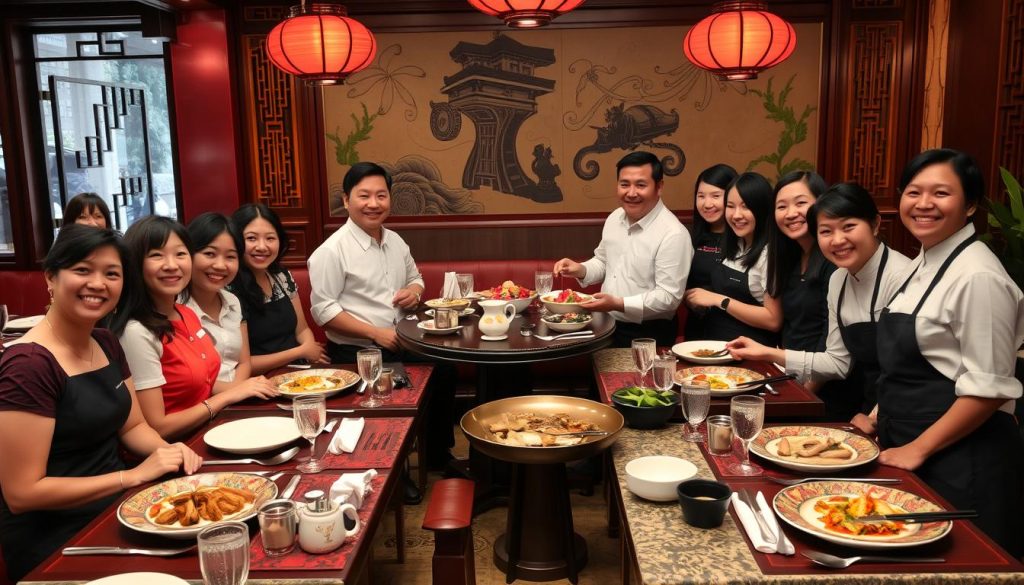
Building a successful restaurant starts with hiring the right team. The staff is the face of the restaurant and greatly affects customer experiences. It’s important to find people who are skilled and fit well with the restaurant’s culture.
Employees should not only be great at cooking but also connect well with all kinds of customers. This makes the dining experience better for everyone.
Training and Cultural Sensitivity
Good restaurant training is key to a skilled team. It covers cooking skills and how to be culturally sensitive. This training helps staff deal with different customers, making the dining area welcoming to all.
Here are some tips for training:
- Start with orientation that shows the value of cultural appreciation.
- Hold workshops to improve cultural understanding and sensitivity.
- Encourage staff to talk about cultural differences to build teamwork.
- Check how training is going and use feedback to get better.
By focusing on hiring the right staff and training them well, you create a warm and successful dining place.
Marketing Strategies for Asian Markets
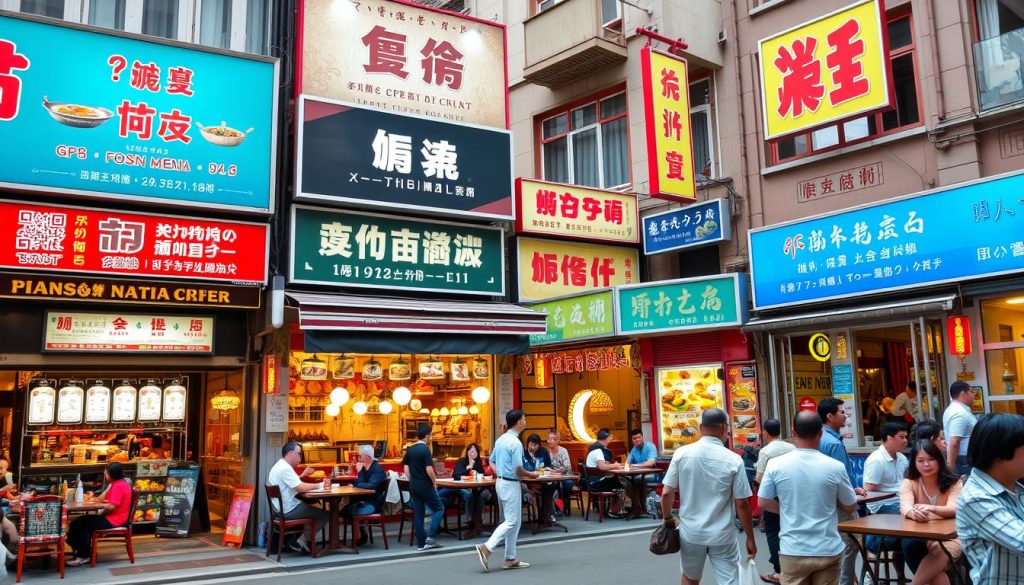
Effective restaurant marketing is key to success in Asia’s lively food scene. Knowing what people like and how they behave helps a lot. Both old-school and new marketing methods can draw in customers and get them to visit.
Successful marketing includes:
- Targeted ads on social media and local papers.
- Special deals that match cultural events and festivals.
- Working with local influencers who are well-known and trusted.
Digital marketing is very important in Asia, where more people use mobiles and order food online. Making content that fits well with social media can help a restaurant get noticed. Talking to followers online builds a loyal customer base.
Mixing cultural insights with modern marketing helps restaurants reach more people. Using these strategies can lead to lasting success in the competitive Asian market.
Utilising Social Media to Boost Visibility
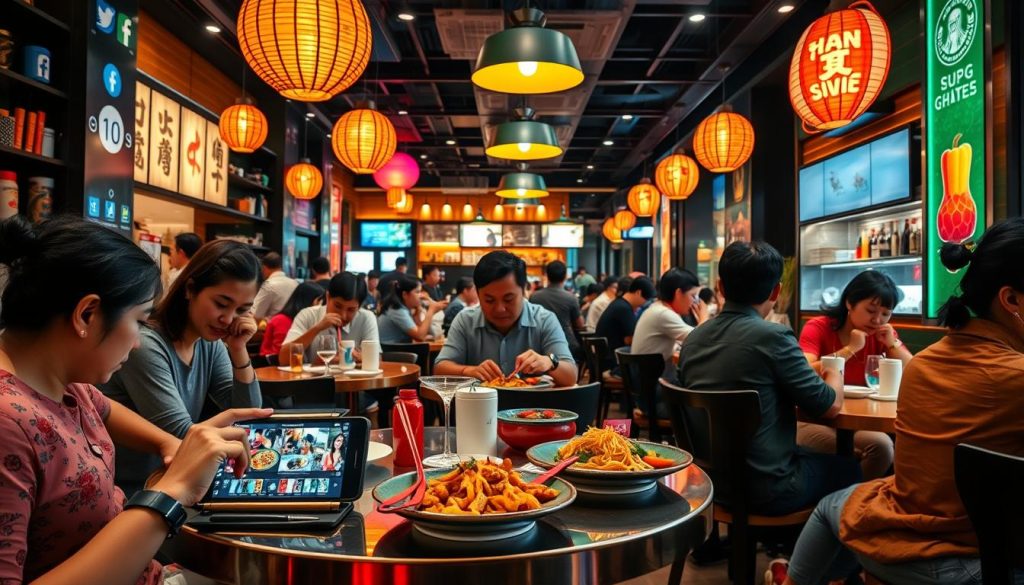
Social media has changed how restaurants talk to customers and show off their food. Sites like Instagram, Facebook, and TikTok are great for getting more people to know about your place. They help restaurants reach more people and build a loyal fan base.
It’s key to post high-quality pictures and videos of your menu on social media. Good visuals grab people’s attention and might make them want to try your food. Telling stories about your restaurant, like where you get your ingredients, can also connect with your audience on an emotional level.
Engaging with customers on social media is important. Reply to comments and messages, and share photos or videos from your customers. This makes your restaurant seem more welcoming and builds a community.
Posting regularly and using interactive content, like polls or contests, keeps people interested. Videos, especially ones that show what goes on behind the scenes, can really boost engagement. As social media keeps evolving, it’s vital for restaurants to keep up and adjust their strategies to stay ahead.
Setting Up Supply Chain Management
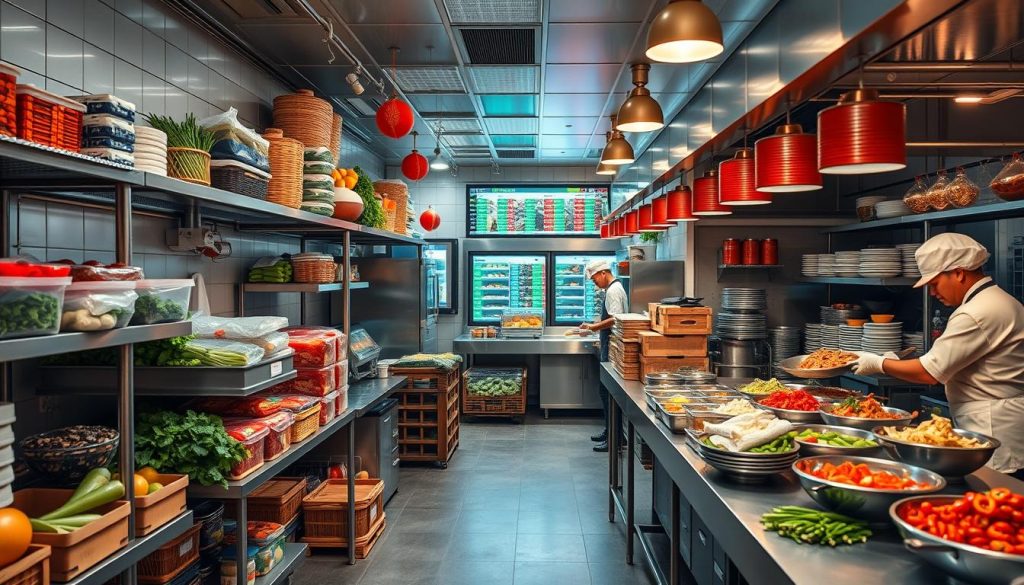
Good restaurant supply chain management is key to success. It’s all about getting the right ingredients to serve quality meals. Fresh and consistent food helps a restaurant’s reputation and keeps things running smoothly.
Building strong ties with suppliers is vital. Working with local farmers means fresher food and supports the community. This approach can lead to lasting partnerships that help both sides.
Good logistics are essential for a smooth food supply. Restaurants need to streamline their operations to avoid delays and waste. Keeping a close eye on delivery times and stock helps keep ingredients flowing and reduces problems.
- Assess suppliers based on quality and reliability.
- Develop clear communication channels with partners.
- Utilise technology for inventory tracking.
- Implement just-in-time ordering to reduce waste.
Improving supply chain management can save a lot of money. By focusing on better ingredient sourcing and efficient food delivery, restaurants can do better. They can also give their customers a great dining experience.
Maintaining Quality Control and Standards
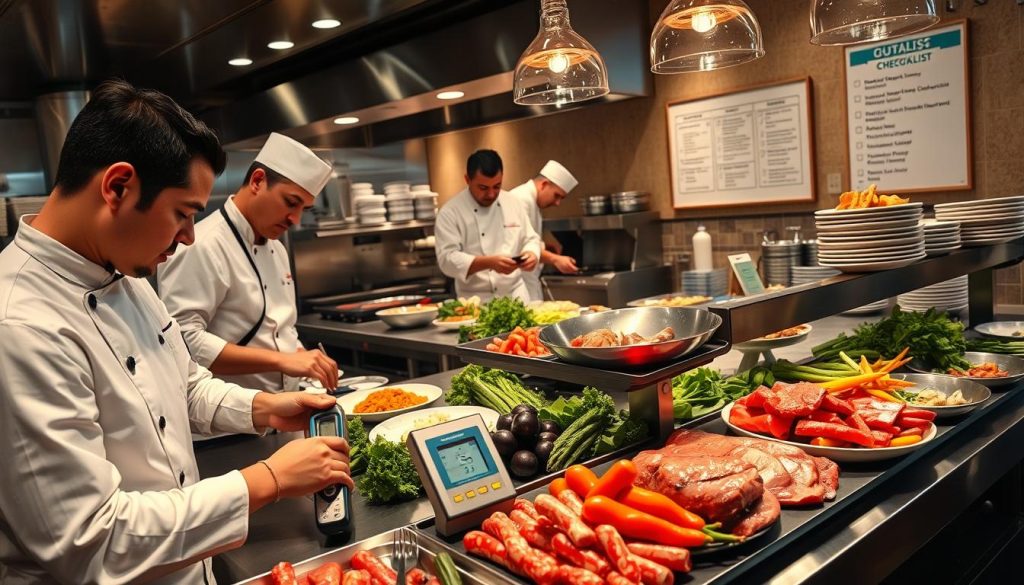
Keeping quality high in restaurants is key to food safety and top-notch food. Many strategies help reach these goals. This ensures guests have a great dining experience.
Setting up strict food safety rules is a big step. This means checking food temperatures, storing food right, and keeping staff clean. Training staff regularly helps them know their part in keeping standards high.
- Regularly check kitchen equipment to make sure it works.
- Use customer feedback to spot areas for improvement.
- Make daily checklists to keep things consistent.
- Have mystery shoppers to get honest reviews.
Quality also means using the best ingredients. Working closely with trusted suppliers means getting fresh, safe food. This shows the restaurant’s commitment to quality, making customers happy and loyal.
In short, quality control in restaurants needs a mix of strict food safety and focus on excellence. Creating a culture of quality and responsibility helps restaurants grow and succeed over time.
Customer Experience: Creating a Unique Dining Atmosphere
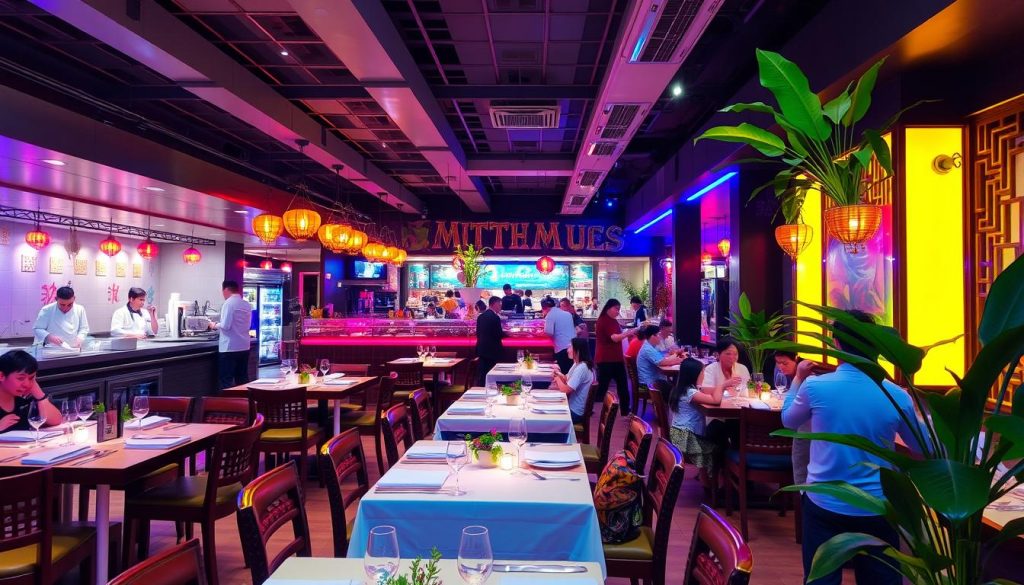
Creating a special dining atmosphere is all about mixing looks and culture. A great dining experience comes from a space that shows off the local culture. By choosing the right décor, seating, and lighting, owners can make a space that looks good and feels special.
Incorporating Local Culture into Design
Adding local culture to the design makes guests feel more connected. This can happen in many ways:
- Art and Décor: Using local art and decor shows pride in the community.
- Seating Arrangements: Seats that encourage talking reflect local dining traditions, making meals more social.
- Lighting Choices: Lighting that matches local buildings creates a welcoming atmosphere, making diners feel at home.
By designing with local culture in mind, restaurants can improve the dining experience. This approach turns a meal into a journey through local heritage, making it unforgettable.
Exploring Sustainability Practices in the Restaurant Business
The world of food is changing, with a big focus on sustainability in restaurants. People are now more aware of the environment and want to eat in places that care about it too. Restaurants that go green attract customers who value the planet.
One way restaurants are helping is by using local ingredients. This cuts down on carbon emissions and boosts local economies. They also work on reducing waste and recycling, which is good for the planet. Big names in the industry are showing it’s possible to be green without losing quality or making customers unhappy.
Restaurants can also save money by being more energy-efficient. Using green energy and modern kitchen tools can lower costs. By doing this, they become leaders in sustainability and appeal to customers who care about the environment. This approach not only helps the planet but also builds loyalty and a strong brand image.

